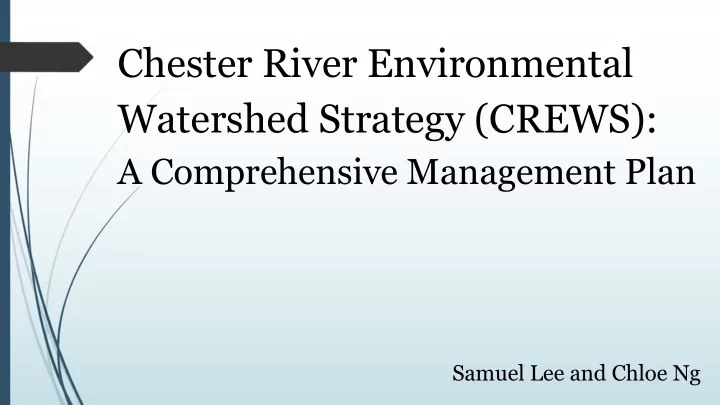

Chester River Environmental Watershed Strategy (CREWS): A Comprehensive Management Plan Samuel Lee and Chloe Ng
Overview Problem Statement ❏ Mission Statement ❏ Goals and Objectives ❏ Background ❏ Location of Chester Management Strategies ❏ Watershed Nutrient Pollution ❏ Sediment Pollution ❏ Boat Pollution ❏ Conclusion ❏
Problem Statement The Chester River currently suffers from two major issues: excessive nutrient loading, which causes eutrophication, and sediment pollution from soil that is washed into the river. Nutrients, such as nitrogen and phosphorus, are received from a variety of sources. While agriculture is undoubtedly a major source, others include lawn fertilizer, septic systems, and wastewater treatment plants. Sediment pollution is also contributed from agricultural sites, as well as many developed areas. In addition to these significant issues, boat pollution threatens the Chester River through boat cleaning, fuel operations, and marine head discharge. A reduction in all of these destructive practices would greatly improve the condition of the Chester River.
Mission Statement The Chester River Environmental Watershed Strategy (CREWS) aims to improve the overall water quality rating of the river through the reduction of nutrient, sediment, and boating pollution. These intentions will all be achieved by the year 2030 with a significant reduction in boat discharge occurring in 2017 and the creation of a Total Maximum Daily Load for sediments transpiring by 2018.
Goals and Objectives In order to improve and protect the water quality, the goals of the Chester River Environmental Watershed Strategy (CREWS) are as follows: 1. Nutrients - By 2030, to limit nitrogen and phosphorus pollution to below the Total Maximum Daily Loads set by the State of Maryland in 2006. This will be accomplished by working with farmers and the community to implement best management practices including cover properly timing fertilizers and the installation of riparian buffers, as well as the installation of other best management practices. 2. Sediments - To establish a science based Total Maximum Daily Load for sediments by 2018. To reduce sediment discharge to these levels by 2030 by working with farmers and the community to implement best management practices including stabilizing river banks using vegetation, planting of cover crops during the non growing season, and implementation of tillage practices that will reduce sediment discharge. 3. Boating Pollution - To reduce pollution from boat discharge by 2017. The Chester River will become a no discharge zone and all waste produced by boats will be pumped out at designated pumping stations or discharged while at sea.
Background
Watershed Characteristics Watershed Drainage: 368 mi 2 ❏ Forms divide between Kent ❏ County and Queen Anne's County in Maryland Headwaters located in Kent ❏ County and New Castle County, DE Population of approximately ❏ 40,000 Major tributary flowing into the ❏ Chesapeake Bay
History Home to Chestertown, Md ❏ 2 nd largest port in Maryland during Revolutionary War ❏ Historic and scenic waterfront still intact ❏ Chestertown Tea Party (1774) ❏
Land Use
Management Organizations ❏ Soil Conservation Districts Kent Soil and Water Conservation District ❏ Queen Anne’s Soil Conservation District ❏ ❏ Maryland Department of Natural Resources ❏ Chester River Association ❏ Chesapeake Bay Trust ❏ Chesapeake Bay Foundation
Current and Previous Plans Middle Chester River Watershed Restoration Action Strategy ❏ Upper Chester River Watershed Restoration Action Strategy ❏ Watershed Report for Biological Impairment of Upper Chester River ❏ Watershed in Kent and Queen Anne’s Counties, Maryland Chesapeake Bay Total Maximum Daily Load ❏ Chesapeake Bay Watershed Implementation Plans ❏
Management Strategies
Nutrient Pollution: Riparian Buffers Provide barrier between ❏ farmland and water Absorbs nutrients and increases ❏ soil stability Switchgrass as buffer plant ❏ Native, fast growing plant with ❏ deep root system Switchgrass as a cash crop ❏ Switchgrass utilized as a buffer
Nutrient Pollution: Fencing off River Install animal fences that prevent animals from entering waterways ❏ Do not allow livestock to roam near flowing water, as they could potentially ❏ contaminate water with waste or cause soil disturbance or erosion
Nutrient Pollution: Precision Farming Utilize GreenSeeker ❏ technology and precision farming, which is the application of fertilizer to only those plants that need it Allows for the application of ❏ less fertilizer ❏ Reduces fertilizer quantities in runoff, which then reduces nutrient pollution Engage farmers and educate ❏ them on precision farming
Sediment Pollution: Cover Crops Plant cover crops, which are crops that are planted on fields after the fall harvest and remain in ❏ the ground during winter Stabilizes the soil and removes excess nutrients that are present in the soil ❏ Reduces nutrient and soil runoff from fields ❏ Work with farmers to increase cover crop acreage ❏
Sediment Pollution: No Tillage Farming Planting of next season of ❏ crops in remnants of previous crops Preserves soil architecture ❏ Crop residue reduces ❏ evaporation Reduces total soil loss ❏
Boat Pollution: No Discharge Zone Require sewage to be pumped at designated ❏ locations at docks rather than flushing sewage into river ❏ Dispose of gas and oil properly (e.g. at a gas station) so that these substances do not end up in waterways Manage trash ❏ Reduce number of items brought onto vessels ❏ Increase amount of reusable materials ❏ Securely collect trash while on vessels ❏ Dispose of trash at designated locations upon ❏ returning to dock
Boat Pollution: Marinas Manage activities that contribute ❏ to the pollution of marina water: ❏ Boat cleaning Fueling operations ❏ ❏ Marine head discharge Reduce stormwater runoff from ❏ marina parking lots and from hull maintenance and repair areas Use less impervious surfaces ❏ Plant more vegetation ❏ Keep areas clean ❏
Recommend
More recommend